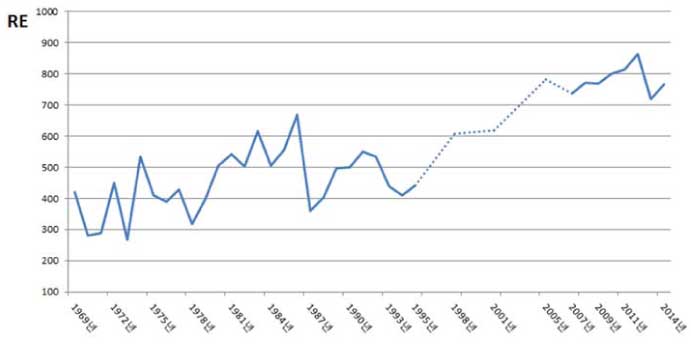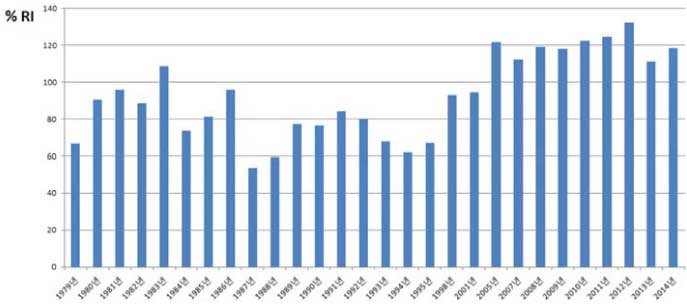Korean J Community Nutr.
2016 Aug;21(4):344-353. 10.5720/kjcn.2016.21.4.344.
Recommended Intake and Dietary Intake of Vitamin A for Koreans by Unit of Retinol Activity Equivalent
- Affiliations
-
- 1Department of Home Economics Education, Korea National University of Education, Cheongju, Korea. youngnam@knue.ac.kr
- KMID: 2351704
- DOI: http://doi.org/10.5720/kjcn.2016.21.4.344
Abstract
OBJECTIVES
New retinol activity equivalent (RAE) was introduced as vitamin A unit in Dietary Reference Intake (DRI) for Koreans 2015. The purpose of this study was to evaluate the adequacy of 2015 reference intake (RI) of vitamin A in RAE unit by the comparison with RI and dietary intake of vitamin A.
METHODS
Analyses on RI of vitamin A were based on the Recommended Dietary Allowances (RDA) for Koreans (1962~2000) and DRIs for Koreans (2005~2015). Analyses on Koreans dietary intake of vitamin A were based on the Korea National Health and Nutrition Examination Survey (KNHNES) reports (1969-2014). For recalculation of RI and dietary intake of vitamin A in RE to RAE, 2013 Koreans intake of retinol: carotenoids ratio of 13: 87 was applied.
RESULTS
RI of vitamin A was 600~750 RE for Korean adult, and 339~425 RAE when calculated by applying the retinol and carotenoids intake ratio. Vitamin A intakes of Koreans were <100% RI, 267~668 RE from 1969 to 2001. From 2005, vitamin A intake had increased to >700 RE, >100% RI. When vitamin A intake was converted from RE to RAE (2005~2014), 718~864 RE became 405.8~488.1 RAE, decreased to 56.5% level. The recent 2015 RI of vitamin A is 850 RAE, two times of 2005 & 2010 RI of 425 RAE for adult male.
CONCLUSIONS
When nutritional status of vitamin A was assessed for Koreans using the estimated average requirement (EAR) of 2015 (570, 460 RAE for male, female adults, respectively), ratio of deficient people increased significantly when judged based on the previous intake of Koreans, <490 RAE. We needs to examine the 2015 RI (EAR) of vitamin A, find a way to measure the accurate intake of dietary vitamin A, and to increase the dietary intake of this vitamin.
MeSH Terms
Figure
Cited by 1 articles
-
Representative Nutrients Contents and Nutritional Adequacy Evaluation of Single-Dish Meal for Middle School Students
Gisun Lee, Youngnam Kim
Korean J Community Nutr. 2018;23(2):93-101. doi: 10.5720/kjcn.2018.23.2.93.
Reference
-
1. Kim HY. Vitamin A. In : Ziegler EE, Filer LJ, editors. Present knowledge in nutrition. 7th ed. Seoul: The Korea Nutrition Society, International Life Sciences Institute of Korea;1998. p. 111–121.2. National Institute of Agricultural Sciences. Food Composition Table, 8th revision [internet]. 2011. cited 2016 Jun 14. Available from: http://koreanfood.rda.go.kr/kfi/fct/fctPdfDwn/list?totalSearchYn=Y.3. Wikipedia. Vitamin A deficiency [internet]. 2006. cited 2016 Jun 14. Available from: https://en.wikipedia.org/wiki/Vitamin_A_deficiency.4. Koo J, Lim HS, Jeong YJ, Yoon JS, Lee AR, Lee JH. Understanding basic nutrition. 1st ed. Seoul: Powerbook;2008. p. 243–250.5. Ministry of Health and Welfare, Korea Centers for Disease Control & Prevention. Korea Health Statistics 2013: Korea National Health and Nutrition Examination Survey [KNHANES VI-1] [internet]. 2014. cited 2016 Jun 14. Available from: https://knhanes.cdc.go.kr/knhanes/index.do.6. Ministry of Health and Welfare. 95 National nutrition survey report. Seoul: Ministry of Health and Welfare;1997. p. 50–53.7. The Korean Nutrition Society. Dietary reference intakes for Koreans. Seoul: The Korean Nutrition Society;2005. p. 83–92.8. Ministry of Health & Welfare, The Korean Nutrition Society, Ministry of Food & Drug Safety. Dietary reference intakes for Koreans. 1st revision. Seoul: Ministry of Health & Welfare, The Korean Nutrition Society, Korea Food & Drug Administration;2010. p. vi–x x iii. p. 149–165.9. Ministry of Health & Welfare, The Korean Nutrition Society. Dietary reference intakes for Koreans 2015. Seoul: Ministry of Health & Welfare, The Korean Nutrition Society;2015. p. 2–23. p. 240–276.10. Korea FAO Association. Recommended dietary allowances for Koreans. Seoul: The FAO Korea Association;1962. p. 13. p. 45.11. Korea FAO Association. Recommended dietary allowances for Koreans. 3rd revision. Seoul: The FAO Korea Association;1980. p. 5p. 19–20.12. Korea Institute for Population and Health. Recommended dietary allowances for Koreans. 4th revision. Seoul: Korea Institute for Population and Health;1985. p. 9p. 27–29.13. Korea Institute for Health and Social Affairs. Recommended dietary allowances for Koreans. 5th revision. Seoul: Korea Institute for Health and Social Affairs;1989. p. 11p. 33–35.14. The Korean Nutrition Society. Recommended dietary allowances for Koreans. 6th revision. Seoul: The Korean Nutrition Society;1995. p. 14p. 127–134.15. The Korean Nutrition Society. Recommended dietary allowances for Koreans. 7th revision. Seoul: The Korean Nutrition Society;2000. p. 83–90. p. 49016. Korea FAO Association. Recommended dietary allowances for Koreans. 1st revision. Seoul: The FAO Korea Association;1967. p. 53–54.17. Korea FAO Association. Recommended dietary allowances for Koreans. 2nd revision. Seoul: The FAO Korea Association;1975. p. 57–58.18. Ministry of Health and Welfare, Korea Centers for Disease Control & Prevention. Korea Health Statistics 2014: Korea National Health and Nutrition Examination Survey [KNHANES VI-2] [internet]. 2015. cited 2016 Jun 14. Available from: https://knhanes.cdc.go.kr/knhanes/index.do.19. Gibson RS. Principles of nutritional assessment. New York Oxford: Oxford University Press;1990. p. 69–70. p. 92–93. p. 101–109. p. 148–152.20. Lee SY, Jeong HJ, Lee YE, Kim MR, Kim KR, Song HN. Food chemistry. Seoul: Powerbook;2009. p. 179–182. p. 260–267.21. Ministry of Health and Welfare, Korea Centers for Disease Control & Prevention. Korea Health Statistics 2009: Korea National Health and Nutrition Examination Survey (KNHANES Ⅳ-3) [internet]. 2010. cited 2016 Jun 14. Available from: https://knhanes.cdc.go.kr/knhanes/index.do.22. Ministry of Health and Welfare, Korea Centers for Disease Control & Prevention. Korea Health Statistics 2008: Korea National Health and Nutrition Examination Survey (KNHANES IV-2) [internet]. 2009. cited 2016 Jun 14. Available from: https://knhanes.cdc.go.kr/knhanes/index.do.23. Kim Y. A study on calculation methods and amounts changes of recommended protein intake in the recommended dietary allowances for Koreans and dietary reference intakes for Koreans. J Korean Home Econ Educ Assoc. 2012; 24(2):51–62.24. Yeum KJ, Lee-Kim YC, Lee KY, Kim BS, Roh JK, Park KS. The serum levels of retinoids, β-carotene and α-tocopherol of cancer patients. J Korean Cancer Assoc. 1992; 24(3):343–351.
- Full Text Links
- Actions
-
Cited
- CITED
-
- Close
- Share
- Similar articles
-
- 2020 Dietary Reference Intakes for Koreans: vitamin A
- Estimated dietary intake of vitamin A in Korean adults: Based on the Korea National Health and Nutrition Examination Survey 2007~2012
- Vitamin A and Vitamin E Status of Diabetic Patients and Normal Adults in Korea
- Intakes and Major Food Sources of Vitamins A and E of Korean Adults Living in Seoul and Gyeonggi Province
- Vitamin A Intake of Exclusively Breast-Fed Infants in Cheongju and Anseong areas



